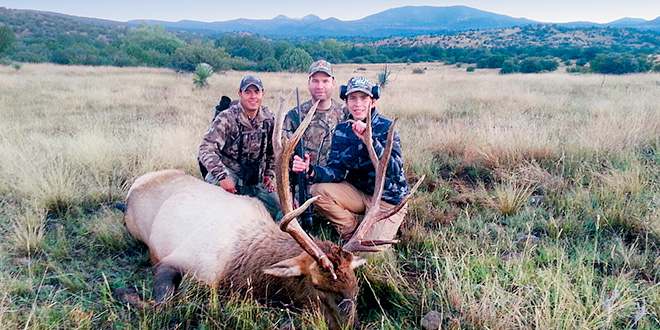Wildlife has no better ally than a conservation officer.
The name alone, “conservation,” suggests their duties involve the protection of wildlife for future generations. Whether they are combating poaching, conducting population surveys, assisting in habitat projects, participating in relocation efforts or con-ducting classroom education, it all points to protecting and enhancing the state’s wildlife resources.
Hunting is another important tool, helping to manage populations, with the license dollars supporting management measures at no cost to state taxpayers.
The entire cycle unfolded before the eyes of Conservation Officer Derek Theobald.
September 2012
Theobald responded to a report of an elk trapped in a cattle guard at Fort Bayard but, after arriving at the scene, was unable to locate the animal.
He called the reporting party, who ex-plained the elk wasn’t stuck between the cattle guard bars; it was trapped in an expansive hole beneath the crossing. Upon closer inspection, in a hole almost big enough for Theobald to stand upright, he spotted a young elk.
The animal was tranquilized and, with the help of a U.S. Forest Service officer, a rope was tied around the animal and pulled out. An ear tag, number 356, was affixed to the animal prior to its release.
October 2015
Nathan Kempton was on his first elk hunt with his father, Brandon, a conservation officer, in Unit 24, including Fort Bayard. Adan Jacquez, a fellow conservation officer, helped guide the young hunter.
The trio set out early one morning and started calling for elk just as the sun was rising. One bull eventually responded and the three began attempting to pinpoint the location.
After moving stealthily for a few hundred yards, a lone bull elk was spotted and the group concealed themselves by a small juniper tree and continued calling. The bull moved slowly in their direction and Nathan got his rifle ready on his shooting sticks
Having recently completed hunter education, Nathan was determined to find the perfect, broadside shot, but it wasn’t there. With the bull now within 100 yards, his father and Jacquez saw an opportunity with a nearly- broadside, quartering-toward shot. Nathan fired and the bull went down almost immediately.
As the group approached the downed animal to begin field dressing the meat they took note of an ear tag. Theobald, who arrived to share in the excitement of a friend’s son harvesting his first elk, noticed the ear tag and decided to check his records.
“It was hard to believe,” Theobald said.
“This was the same same elk that was stuck three years earlier. And we weren’t terribly far from that same spot.”
That young elk from the cattle guard had grown into a nice, mature 7×7 bull.
Trapped beneath the cattle guard, the animal easily could have starved to death. Instead, it was rescued, matured to a bull, had ample opportunity to reproduce and pass on its genetics and was then harvested to feed a family.
Hunting, fishing and trapping fund wildlife conservation, and sportsmen and women should be thanked. However, don’t forget about the conservation officers; you never know what might have become of your harvest without them.
 New Mexico Wildlife magazine Conserving New Mexico's Wildlife for Future Generations
New Mexico Wildlife magazine Conserving New Mexico's Wildlife for Future Generations
